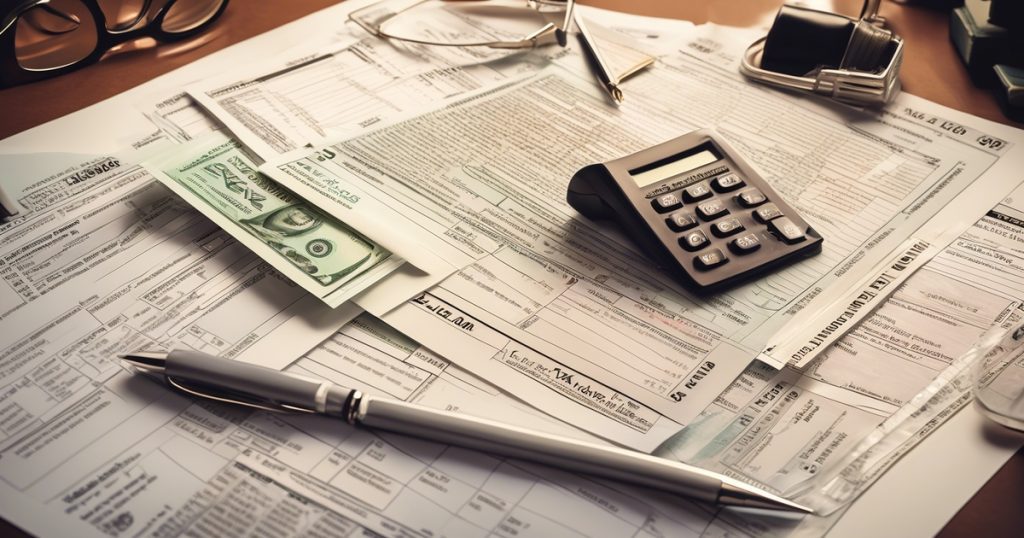Are you aware of how bankruptcy can impact tax liens? Understanding this connection is crucial for navigating financial challenges. Bankruptcy has significant implications on tax liens, unsecured creditors, mortgage, affecting your assets and liabilities in complex ways. It’s essential to grasp the interplay between bankruptcy proceedings, interest, unsecured creditors, and tax obligations to make informed decisions about your financial future. Stay tuned to explore the intricate relationship between bankruptcy and tax liens, uncovering insights that can help you navigate these intricate financial landscapes effectively.
Key Takeaways
- Understanding Tax Liens: Tax liens can have significant implications on your financial well-being and assets.
- Chapter 7 Bankruptcy Basics: Chapter 7 bankruptcy provides a way to discharge certain debts, including tax liabilities under specific conditions.
- Addressing Pre-Filing Tax Liens: Before filing for bankruptcy, it’s crucial to understand how pre-existing tax liens may be treated in the process.
- Managing Post-Filing Tax Liens: After filing for bankruptcy, it’s essential to navigate how tax liens are handled to protect your assets.
- Eliminating Tax Liens Through Bankruptcy: Bankruptcy can offer a path to eliminate tax liens, providing a fresh start financially.
- Life After Bankruptcy: Even after bankruptcy, it’s important to plan for the future and manage your finances responsibly.
Understanding Tax Liens
Definition
Bankruptcy, in the context of tax liens, refers to a legal process where an individual or entity declares inability to repay debts. The presence of tax liens adds complexity to bankruptcy proceedings, impacting the priority of debt repayment for unsecured creditors. Understanding this relationship is crucial for navigating the legal implications effectively.
Types
Various types of tax liens can be influenced by bankruptcy, including federal and state tax liens. Federal tax liens are imposed by the IRS for unpaid taxes at the federal level, while state tax liens are issued by state agencies. The type of tax lien dictates how it will be treated during bankruptcy proceedings, affecting the priority of repayment and potential discharge.
Impact on Assets
Bankruptcy can have a significant impact on assets encumbered by tax liens in the estate. Assets, including property, may face potential loss or protection depending on the specific circumstances of the case, bankruptcy estate, trustee, or tax lien. During bankruptcy, assets with tax liens may be subject to liquidation to satisfy outstanding tax obligations. Understanding the implications of asset liquidation is vital for individuals facing bankruptcy with associated tax liens.
Chapter 7 Bankruptcy Basics
Process Overview
Bankruptcy begins with filing a petition, including financial details, tax lien information, and estate property. Next, the court appoints a trustee to oversee the case. Subsequently, assets are evaluated for liquidation to repay debts. During this process, tax liens are identified and categorized based on priority levels. Finally, the bankruptcy concludes with a discharge of eligible debts, including tax liens, trustee, estate, and property.
Qualifications
Individuals must meet specific criteria to qualify for Chapter 7 bankruptcy with tax liens. Firstly, they must pass the means test to demonstrate financial need for relief. Secondly, attending credit counseling within six months before filing is mandatory. Meeting these qualifications significantly impacts the outcome of the bankruptcy process, determining if debts can be discharged by the trustee.
Effects on Debts
Bankruptcy has significant implications for debts linked to tax liens. Debts related to tax liens can be discharged in Chapter 7 bankruptcy under certain conditions by the trustee. However, priority tax debts may not be fully eliminated. Moreover, bankruptcy affects debt obligations long-term by providing a fresh start while impacting credit scores.
Tax Liens in Chapter 7 Bankruptcy
Pre-Filing Liens
Before filing for Chapter 7 bankruptcy, individuals may have pre-existing tax liens on their property, indicating a debt owed to the government. It is crucial for the trustee to address these liens on the property as they can complicate the bankruptcy process. Strategies such as negotiating with tax authorities or seeking lien removal are common approaches to handle pre-filing tax liens.
Planning for bankruptcy should include addressing pre-filing liens on property to prevent potential complications during the bankruptcy proceedings. Failure to resolve these liens beforehand can lead to delays or even the loss of assets, including property, during the bankruptcy process. Seeking professional advice early on can help individuals navigate this complex aspect of bankruptcy planning effectively.
Post-Filing Liens
After filing for Chapter 7 bankruptcy, any new tax liens that arise are typically treated differently from pre-existing ones. Post-filing tax liens can impact the individual’s ability to discharge certain tax debts through bankruptcy. Understanding how these new liens affect the bankruptcy process is essential for successful debt relief.
Post-filing tax liens may result in creditors having priority claims over certain assets, complicating the distribution of assets during bankruptcy. To manage post-filing tax liens effectively, individuals should stay informed about their rights and obligations under bankruptcy law. Seeking legal counsel can provide valuable guidance on navigating post-filing lien issues in the bankruptcy estate and property.
What Happens to Tax Liens
During Bankruptcy
When individuals file for bankruptcy, tax liens and property become crucial aspects that need careful consideration. Bankruptcy proceedings can impact the treatment of tax liens and property, influencing how they are addressed within the legal framework. The presence of tax liens can affect the priority of creditors during bankruptcy cases.
Tax liens play a significant role in the bankruptcy timeline. They can determine the distribution of assets, property, and payments to various creditors, including tax lien holders and the bankruptcy estate. The status of tax liens affects the overall outcome of the bankruptcy process, shaping how debts are settled and resolved. Understanding the implications of tax liens is essential for navigating through bankruptcy successfully.

After Discharge
After receiving a discharge in bankruptcy, the status of tax liens on property undergoes changes. Discharged tax liens no longer hold the same legal weight as before, impacting financial obligations significantly. Individuals must be aware that while personal liability for discharged tax debts is eliminated, the actual tax lien on properties and bankruptcy estate may still remain.
Discharged tax liens have implications on financial obligations post-bankruptcy discharge. Individuals should address any remaining tax liens promptly to prevent future complications or legal issues. It is advisable to seek professional guidance on handling discharged tax liens to ensure compliance with legal requirements and financial responsibilities.
Addressing Pre-Filing Tax Liens
Identification
To identify tax liens before bankruptcy, review credit reports and public records for any outstanding tax debts. Accurately identifying these liens is crucial for bankruptcy proceedings to ensure all debts are properly addressed. Resources like the IRS website and local tax offices can help verify tax lien information during bankruptcy.
During bankruptcy, it’s essential to accurately identify any existing tax liens to address them appropriately. This process involves thorough research into federal, state, and local tax authorities to ensure all liens are accounted for in the bankruptcy filing. Utilizing online databases and seeking professional advice can aid in this identification process.
Resolution Strategies
When addressing tax liens within bankruptcy, consider negotiation tactics to reach favorable resolutions. Negotiating with tax authorities can lead to reduced amounts or extended payment terms for these liens. Seeking the assistance of a qualified attorney experienced in bankruptcy and tax law can enhance negotiation outcomes.
In bankruptcy proceedings, various strategies can be employed to settle tax liens effectively. One option is to propose a repayment plan that satisfies both the debtor and the taxing authority while addressing any existing lien. Another strategy involves utilizing exemptions or negotiating with creditors to release their claims on specific assets, allowing for a smoother resolution of tax liens.
Managing Post-Filing Tax Liens
Avoidance
Avoiding tax liens in bankruptcy is crucial. Proactively engaging with the taxing authority can prevent tax issues post-filing. Implementing proper financial management strategies is essential to avoid tax lien complications during bankruptcy proceedings. Seeking professional advice can guide individuals in navigating the complexities of tax obligations, including lien, during bankruptcy.
Payment Plans
Payment plans offer a structured approach to address tax liens post-bankruptcy. Installment plans allow debtors to settle tax debts over a period, easing financial burdens. These plans provide a feasible method for managing tax liabilities while ensuring compliance with bankruptcy requirements and lien. Establishing realistic payment schedules can facilitate the resolution of tax lien issues effectively.
Eliminating Tax Liens Through Bankruptcy
Feasibility
Navigating tax liens during bankruptcy requires careful consideration of feasibility. Factors like the type of tax owed, its priority, and lien influence the process. Understanding these aspects is crucial in determining the practicality of addressing tax liens within bankruptcy proceedings.
Assessing feasibility involves evaluating the nature of the tax debt. Different types of taxes, such as income or property taxes, have varying impacts on bankruptcy proceedings. Prioritizing tax debts based on their classification is essential for a successful resolution.
In determining feasibility, one must also consider the timing of the tax lien filing. The point at which the lien was placed can affect its treatment in bankruptcy. Early filings may have different implications compared to liens filed closer to the bankruptcy petition date.
Procedure
Addressing tax liens in bankruptcy follows a specific set of procedural requirements. Documentation plays a crucial role in this process, requiring accurate records of all outstanding tax liabilities. Providing detailed information about these debts is necessary for a smooth resolution.
The procedural steps for managing tax liens during bankruptcy involve a series of actions aimed at resolving outstanding tax obligations. These steps include disclosing all debts to the court, working with creditors to establish payment plans, and adhering to court-mandated timelines for repayment.
Clear outlines detailing procedural aspects related to tax liens in bankruptcy are essential for ensuring compliance with legal requirements. Proper documentation submission and adherence to court directives are key components in successfully managing tax liens within a bankruptcy framework.
Personal Property and Tax Liens
Protection Measures
When facing tax liens in bankruptcy, individuals can take protective measures to safeguard their assets. By utilizing exemptions, certain personal property and real estate can be shielded from seizure during bankruptcy proceedings. Strategies such as strategically allocating exemptions based on the value of the assets can help minimize the impact of tax liens on protected belongings.
One way to protect personal property from tax liens is by understanding the exemption laws in place. These laws outline specific types of assets that are exempt from seizure, such as household furniture and essential items for daily living. By leveraging these exemptions, individuals can ensure that crucial possessions remain untouched during bankruptcy.
Utilizing exemption strategies effectively involves careful planning and assessment of one’s assets. By accurately valuing personal property and claiming the appropriate exemptions, individuals can safeguard valuable belongings from being encumbered by tax liens. Seeking professional guidance from a bankruptcy attorney can also aid in navigating the complex process of asset protection during bankruptcy proceedings.
Exemption Claims
To claim exemptions for assets in bankruptcy with tax liens, individuals must follow a structured process. This involves identifying eligible assets that fall under exemption categories specified by bankruptcy laws. Documentation supporting the value and nature of these assets is crucial for successful exemption claims during bankruptcy proceedings.
Eligibility criteria for exemption claims vary depending on the type of asset and its value. Commonly used exemptions include those related to primary residences, vehicles, retirement accounts, and personal belongings necessary for daily living. Providing accurate documentation and meeting all eligibility requirements are essential steps in securing exemptions to protect assets from tax liens.
For example, homeowners may utilize the homestead exemption to safeguard their primary residence from tax liens in bankruptcy. By claiming this exemption within the specified limits set by state laws, individuals can ensure that their home remains protected from seizure due to outstanding tax debts.
Life After Bankruptcy
Credit Rebuilding
Rebuilding credit post-bankruptcy with tax liens is crucial for financial recovery. Strategies include timely bill payments and responsible credit card usage. Prioritize resolving tax liens to improve credit scores and regain financial stability. Establishing new lines of credit can also boost creditworthiness after bankruptcy.
Navigating life after bankruptcy involves understanding the importance of rebuilding credit. Resolving tax liens through bankruptcy sets the foundation for a fresh financial start. Improving credit scores requires consistent efforts, such as monitoring credit reports for errors and maintaining low credit card balances. Seeking guidance from financial advisors can aid in developing effective strategies for rebuilding credit post-bankruptcy.
Lien Releases
Obtaining lien releases post-bankruptcy discharge is essential to clear titles and resolve debts. The process involves submitting necessary documentation to relevant authorities for lien removal. Significance of lien releases lies in releasing encumbrances on properties, allowing individuals to regain full ownership rights. Clearing tax liens through bankruptcy paves the way for obtaining lien releases efficiently.
Understanding the significance of lien releases is vital in the journey towards financial recovery after bankruptcy. These releases play a critical role in eliminating financial burdens associated with tax liens, enabling individuals to move forward with a clean slate. Navigating the lien release process effectively requires attention to detail and timely submission of required paperwork. Seeking legal counsel can streamline the process and ensure successful resolution of liens post-bankruptcy.

Closing Thoughts
You’ve learned how bankruptcy can impact tax liens, from understanding their implications to managing them effectively. By navigating Chapter 7 bankruptcy and its interaction with tax liens, you’ve gained insights into addressing pre-filing and post-filing challenges. Remember, eliminating tax liens through bankruptcy offers a fresh start and a path towards financial freedom.
As you move forward, consider consulting with legal professionals to tailor solutions to your specific circumstances. Stay proactive in managing your finances post-bankruptcy to ensure a stable financial future. Empower yourself with knowledge and take decisive steps towards resolving tax lien issues effectively. Your journey to financial recovery starts now.
Frequently Asked Questions
How do tax liens impact individuals filing for Chapter 7 bankruptcy?
Tax liens can complicate Chapter 7 bankruptcy by affecting the priority of debt repayment. Understanding how tax liens are treated in bankruptcy proceedings is crucial for individuals seeking debt relief.
Can tax liens be eliminated through Chapter 7 bankruptcy?
Yes, certain types of tax liens can be discharged in Chapter 7 bankruptcy if they meet specific criteria. Working with a knowledgeable attorney can help navigate the process and determine eligibility.
What are pre-filing tax liens, and how should they be addressed before filing for bankruptcy?
Pre-filing tax liens are claims imposed by the government on property due to unpaid taxes. Addressing these liens before filing for bankruptcy involves assessing their impact on assets and developing a strategy to manage them effectively.
How can individuals manage post-filing tax liens during Chapter 7 bankruptcy proceedings?
Managing post-filing tax liens requires timely communication with creditors, understanding the implications of these liens on assets, and complying with legal requirements. Seeking professional guidance can help individuals navigate this complex phase successfully.
What happens to personal property encumbered by tax liens in Chapter 7 bankruptcy?
In Chapter 7 bankruptcy, personal property encumbered by tax liens may be subject to liquidation to satisfy the debts owed. Understanding the exemptions available and working closely with legal counsel can help protect essential assets during this process.




